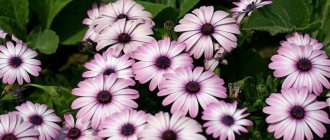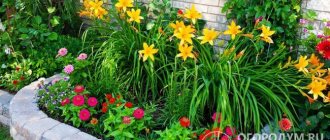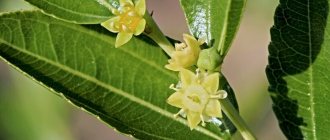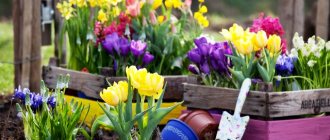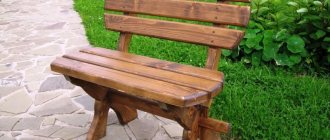- Marigold
- Gaillardia
After a cold, colorless and such a long winter, I really want bright colors. Flowering plants provide a varied color palette with all sorts of shades. Every gardener dreams that all corners of the garden will be decorated, and this beauty will remain from early spring until late autumn. Is it possible to choose flowers for a flower bed that bloom all summer – we’ll tell you in the article.
The species and varietal assortment of flowering annuals and perennials is very diverse, which gives enormous scope for imagination in choosing compositions for any type of flower garden
What to consider before planting perennial flowers
- Most perennials take a long time to grow, first strengthening their root system. Therefore, even if some of them bloom in the year of planting, it will not be too abundant. The same applies to seedlings with flowers that have already appeared. Good flowering should be expected next year or in a few years. If time is running out, plant annuals.
- Flowers planted in autumn can withstand frosts more easily and are less susceptible to illness. Before planting, the soil must be dug up and fertilized, and then the flowerbed must be covered with sawdust, moss or dry grass.
- The flowering period may vary depending on the plant variety. More accurate information about planting and flowering times, as well as proper care, is always indicated on the seed package.
How to choose perennials for a summer house in the Moscow region
When choosing garden perennial flowers for the Moscow region, it is necessary to take into account the climatic conditions of this region. Therefore, it is necessary to give preference to crops that are characterized by their low maintenance requirements, increased frost resistance and tolerance to sudden temperature changes. You should also take into account the duration of flowering and the preferences of the crop when placing it on the site. This will allow you to select perennials that can complement each other.
Buying flowers is not a problem, the main thing is to plant them correctly. Therefore, before choosing perennial plants for your garden, you need to draw up a diagram of their location on the site, taking into account their growing preferences. You should also pay attention to height, suggesting that low-growing flowers should be used for the foreground, and tall ones should be used to create a beautiful background.
Delphinium
- How to plant: seedlings or seeds.
- When to plant: seedlings - in late May or early June; seeds - in October - November.
- Where to plant: in a sunny, windless place or in partial shade.
- When to bloom: through the summer.
- How long they bloom: from July to late summer.
This tall plant with bright flowers is often planted along fences or walls. Delphinium loves the sun, but it must be planted where there will be shade during the midday hours. Scorching rays can burn delicate flowers. As necessary, the plant should be watered at the root and faded inflorescences removed from it.
Coreopsis
Known under the names “Parisian Beauty” and “Lenok”. On tall leafless peduncles (about 60 cm) stand single yellow flowers, the structure of which resembles daisies. Blooms profusely in June and August. Between two waves, flowering does not stop, its intensity simply decreases. The rosette of bright green leaves is compact, up to 30 cm high.
Echinacea
- How to plant: seedlings or seeds.
- When to plant: seedlings - at the end of May; seeds - in October - November.
- Where to plant: in a sunny location.
- When to bloom: through the summer.
- How long they bloom: from July to September.
The plant loves sunny color; it will not bloom well in the shade. Echinacea is not afraid of drought, but still requires periodic watering, as well as weeding and loosening the soil. Flowers are great for creating bouquets because they do not wither for a long time.
Aquilegia
- How to plant: seedlings or seeds.
- When to plant: seedlings - in early June; seeds - in September or in the second half of April.
- Where to plant: in partial shade.
- When to bloom: through the summer.
- How long they bloom: from June to July.
Aquilegia prefers to grow in partial shade. In the sun it develops more slowly and does not bloom as profusely. The plant needs to be regularly watered and weeded, and the top layer of soil underneath must be loosened.
Helenium
commons.wikimedia.org
- How to plant: seedlings or seeds.
- When to plant: seedlings - in late May or early June; seeds - in October - November or early April.
- Where to plant: in sunny or partial shade.
- When to bloom: through the summer.
- How long they bloom: from July to September.
This plant with large, bright flowers needs regular watering and periodic loosening of the soil. And for long-term flowering, faded inflorescences need to be cut off from helenium.
Garden plants blooming in the second half of summer: from July to August
Summer-flowering perennial herbaceous plants: Aconite (fighter), Althea, Astilbe, Perennial Aster, Astrantia, Buzulnik (ligularia), Bukvitsa (betonika), Valerian, Cornflowers, Basilifolia, Milkweed (asclepias, swallowtail), Loosestrife, Vessel, Gaillardia, Heuchera, Helenium, Helipterum, Gypsophila, Polygonum, Gravilat, Elecampane, Delphinium, Loosestrap, oregano, St. John's wort, Incarvillea, Iris, Hyssop, Kermek (statice, limonium), Kniphofia, Campanula, Commelina, Mullein, Burnet, Meadowsweet, Lavatera, Lakonos (phytolacca), Liatris, Daylily, Lilies, Lychnis, Macleya, Small petal (erigeron), Juvenile (tenacious), Monarda, Mordovnik, Soapwort, Mint, Nilet (popovnik, garden chamomile), Sedum (sedum), Pyrethrum (pink chamomile ), Platycodon (widebell), Navel (antemis), Rudbeckia, Sydalcea, Eryngium, Sinyukha (polemonium), Sisyurynchia (dwarf iris), Scabiosa, Sunflower (heliopsis), Sunflower (helianthemum), Stachys (hare's ears), Tradescantia, Yarrow , Physostegia, Hosta, Cohosh, Blackhead (Prunella), Stock-rose (mallow, mallow, alcea), Edelweiss
Cereline-late summer flowers: Phlox, Physostegia, Daylily, Rudbeckia
Aquatic and semi-aquatic summer-flowering plants: Capsule, Nymphea (water lily), Nymphaeum (marsh flower), Pontederia, Arrow leaf,
Summer-flowering bulbous plants: Zygadenus, Canna, Eukomis (Eukomis), Oxalis Depp, Lilies
Summer-flowering vines: Tladiantha, Climbing rose, Clematis, Hydrangea, Hops
The most popular annual vines for the garden>>>
Trees and shrubs that bloom in summer: Buddleia, Weigela, Heather, Hydrangea (hydrangia), Deutzia, Gorse, Rose (rose hip), Fieldfare, Spiraea, Erica
Yarrow
- How to plant: seedlings or seeds.
- When to plant: seedlings - at the end of May; seeds - in October - November or April.
- Where to plant: in sunny or partial shade.
- When to bloom: through the summer.
- How long they bloom: from June to August.
This plant with many tiny flowers and leaves can go without water for a long time. Even in drought, it can only be watered once a week.
Thrift
- How to plant: seedlings or seeds.
- When to plant: seedlings - at the end of May; seeds - in October or early April.
- Where to plant: in sunny or partial shade.
- When to bloom: through the summer.
- How long they bloom: from July to August.
Armeria is distinguished by dense, bright inflorescences. This plant loves moisture, so it needs to be watered often, especially before flowering. It is also necessary to remove faded inflorescences from it.
Bell
- How to plant: seedlings or seeds.
- When to plant: seedlings - at the end of May; seeds - at the end of May or October.
- Where to plant: in sunny or partial shade.
- When they bloom: when planting seedlings - in the same year; when planting seeds - every other summer.
- How long they bloom: from June to September.
Bells are very unpretentious. They need to be watered only when the soil dries out. For abundant flowering, faded flowers should be cut off from bluebells.
Astrantia
- How to plant: seedlings or seeds.
- When to plant: seedlings - in late May or early June; seeds - in October - November.
- Where to plant: in sunny or partial shade.
- When they bloom: 2–3 years after planting.
- How long they bloom: from June to August.
Astrantia has very unusual large inflorescences. This unpretentious plant can grow even in the shade, but in this case it will not bloom as profusely as in a lighted place. Astrantia needs to be periodically watered, weeded and removed from old inflorescences.
Heliopsis
Most hybrids and varieties are cultivated from heliopsis sunflower, or false sunflower. A distinctive feature of the perennial is its tall, erect stems, large bright yellow flowers, similar to daisies, and the ability to quickly take over territory.
Heliopsis blooms from early June to late August. By the end of the growing season, long shoots (up to 1.6 m) weaken, and they have to be either tied to supports or tied together in a bunch. Heliopsis is used as a background plant in mixborders, rural and natural landscapes.
Mallow
- How to plant: seedlings or seeds.
- When to plant: seedlings - in late May or early June; seeds - in October - November or at the end of April.
- Where to plant: in a sunny, windless place or in partial shade.
- When to bloom: through the summer.
- How long they bloom: from June to September.
Mallow grows tall, so if necessary it needs to be tied up. You can water the plant a couple of times a week, and in hot weather - a little more often. In addition, for better flowering, you should cut off faded flowers.
Clematis
- How to plant: seedlings.
- When to plant: late May or September.
- Where to plant: in a sunny, windless place or in partial shade.
- When they bloom: 2–4 years after planting.
- How long they bloom: from July to September.
This is a climbing plant, so it must be planted next to some kind of support, the shoots should be directed along it during the growth period and tied up. The flower needs to be watered several times a week, periodically fertilized and loosened the soil under it.
With good care, clematis can grow in one place for more than 20 years. But in the first years you should not expect abundant flowering, because the plant is only growing its root system. By cutting off all the buds at this time, you will help it strengthen its roots.
Fuchsia
The whimsical fuchsia lantern buds feel at ease in a fresh, cool and humid climate, but cannot stand the scorching sun and heat, so the crop is well suited for planting on the north side of the house. The abundant flowering of this beauty strongly depends on the saturation of the soil with valuable minerals, mainly nitrogen. During the warm season, fuchsia can be planted in the garden, preferably by burying it in the ground directly in a pot, so that it can be easily removed and taken into the house in the fall.
Cuff
- How to plant: seedlings.
- When to plant: late May.
- Where to plant: in sunny or partial shade.
- When to bloom: through the summer.
- How long they bloom: from June to August.
The cuff has such tiny flowers that from a distance it resembles just a lush bush. It makes a beautiful living border. The plant needs to be watered periodically. And if you cut off the faded inflorescences, you can achieve re-blooming in the fall.
What flowers to plant in a flowerbed to bloom from spring to autumn
Perennials for spring and early summer
These are some of the best spring-blooming perennials, best suited for a shady area to create a beautiful perennial bed:
Tulips • Snowdrops • Muscari • Hyacinths • Irises • Daffodils • Crocuses • Primrose • Periwinkle
Tulips
Snowdrops
Muscari
Hyacinths
Irises
Daffodils
Crocuses
Primrose
Periwinkle
Summer flowering perennials
These are some of the best perennials for flower beds that bloom at their peak in the summer months:
Dahlias • Roses • Daylily • Delphinium • Speedwell • Poppies • Anemones • Astilbe • Sage
Dahlias
Roses
Day-lily
Delphinium
Veronica
poppies
Anemone
Astilbe
Sage
Perennials for late summer and early fall
These are some of the best fall-blooming perennials, starting to bloom in late August and continuing into the fall:
Chrysanthemums • Perennial asters • Echinacea • Helenium • Rudbeckia • Coreopsis • Goldenrod • Yarrow • Sedum
Chrysanthemums Perennial asters Echinacea Helenium Rudbeckia Coreopsis Goldenrod Yarrow Sedum
Astilbe
- How to plant: seedlings.
- When to plant: late May - early June or September.
- Where to plant: in partial shade.
- When they bloom: 2–3 years after planting.
- How long they bloom: from July to August.
Astilbe can hardly tolerate drought, so it needs regular watering. It will bloom more abundantly if planted next to a pond. Thanks to its lush leaves, this bush-like plant will decorate the garden even after flowering.
Arabis
commons.wikimedia.org
- How to plant: seedlings or seeds.
- When to plant: seedlings - at the end of May; seeds - in October - November or at the end of April.
- Where to plant: in a sunny location.
- When to bloom: through the summer.
- How long they bloom: from May to July.
Arabis grows in a low carpet of small, beautiful flowers. They exude a pleasant sweetish aroma. The plant needs to be watered only during dry periods. However, it requires periodic loosening of the top layer of soil.
Lupine
- How to plant: seedlings or seeds.
- When to plant: seedlings - at the end of May; seeds - in October - November or mid-April.
- Where to plant: in a sunny, windless place or in partial shade.
- When to bloom: through the summer.
- How long they bloom: from June to July.
This plant has very beautiful elongated inflorescences of different shades. Perennial lupine needs to be watered regularly. And if you cut off the flowering stems from it in time, you can achieve repeated flowering at the end of summer. Sometimes lupine can bloom in the year of planting, at the end of summer.
Low growing plants
Low-growing flowering plants are very popular in landscape design. They act as edging for garden paths, country flower beds, and essential members of rock gardens.
In cities, low-growing annuals are planted in large flower beds, mainly in squares; they are used to create long ridges in parks and squares, placed in the form of bright ornaments and three-dimensional figures, and used to decorate the slopes of embankments.
They also solo in container culture. A variety of flowerpots, flower stands, and wooden boxes with short flowers are displayed near cinemas and art galleries, shops and entertainment complexes, along the perimeter of summer cafes and restaurants.
To decorate terraces, gazebos, and balconies, hanging forms planted in boxes, pots, and hanging baskets are often used.
Alyssum , begonia everflowering , brachycoma , bacopa , gypsophila graceful , lobelia , lobularia , nemesia , petunia , eschscholzia , Drummond's phlox , low-growing varieties of marigolds , snapdragons , gillyflower , zinnia and salvia - this is a list of continuous flowering annuals. You can learn more about low-growing flowers from the article on our website.
Lobularia
Previously, alyssum and lobularia were classified as one genus of the Brassica family, then they were divided into two closely related taxa: white, lilac, pink annuals began to be classified as the genus Lobularia, perennial yellow and white ones - to the genus Alyssum, such as rock alyssum. But the confusion continues to this day. So, in the spring of this year I purchased a bag of agro seeds, on which it is written: Alyssum maritime “Mountain Snow”, and below is the Latin name Lobularia maritime.
Disputes are disputes, but this plant, along with alyssum, should definitely be in your flower collection. It is propagated by sowing seeds through seedlings and in open ground. Grows in light and partial shade . Forms whole clouds of small flowers with a honey aroma. Trimming in mid-summer is guaranteed to prolong flowering time. I removed the last two pots with flowering plants from my open balcony only at the end of November (Tver region).
Producers of seed material offer a small variety of varieties, but there is a choice: “Rosie O’day”, “Oriental Nights”, “Royal Carpet”, “Purple Queen”, and new products - “Sweetie Lavender” and “Bronze”.
Lobularia, like alyssum, looks good along paths, on alpine hills, in the edging of flower beds, and in containers
Salvia
Salvia belongs to the genus Sage of the Lamiaceae family. Various varieties of salvia shiny (sparkling) are grown in cultivation. She loves a sunny location, moderate watering and feeding. It has compact, pyramidal bushes, opposite leaves and racemose inflorescences consisting of a large number of large flowers. Popular varieties with red coloring: “Scarlett Piccolo”, “Vesuvius”, “Fire Magic”; orange "Reddy Salmon", lilac "Reddy Lavender", pink "Vista Rose Elite".
Red and white salvia “Surprise”, growing up to 20-25 cm, looks very elegant
Phlox Drummond
Phlox or Drummond's flame, a representative of the Sinyukhov family, has many varieties, forms, and varieties. It has a straight, dividedly branched stem, covered with hairs, oval-elongated, fleecy leaves. The flowers are medium-sized, tubular, with a bend, five-lobed, collected in fairly large umbrella-shaped shields, noticeable from a distance. The coloring is very diverse: there are single-color, two- and multi-color phloxes, with an eye, a spot, stripes, and a border. The shape of the corolla is also different: from simple to star-shaped. The flowers have a pleasant aroma.
Low-growing and dwarf phloxes are planted in flower beds, rockeries, boxes, and pots; hanging forms - in balcony boxes, flowerpots, flower pots.
Interesting color combinations are obtained when sowing mixtures of seeds, for example, the “Starry Rain” variety
Among the low perennials you can plant rock alyssum , pinnate carnation , sunflower , false sedum , and some varieties of saxifrage .
Sedum (sedum) false “Tricolor” is valued not so much for its flowering in July - August, but for its beautiful white-green leaves, which by autumn will also acquire a pink tint
Carnation
- How to plant: seedlings or seeds.
- When to plant: seedlings - at the end of May; seeds - in the first half of May or October - November.
- Where to plant: in a sunny location.
- When to bloom: through the summer.
- How long they bloom: from June to September.
There are many varieties of this plant, the appearance of which can vary significantly. Carnation tolerates cold and even drought well, but loves sunlight. Perennial carnations need to be watered only when the soil dries out, periodically loosen the soil under it and cut off wilted flowers from it.
Thuja
The spherical dwarf thuja does not bloom at all, but when displayed on a loggia or porch in large pots and tubs it looks wonderful. She needs a spacious container with good drainage and slightly acidic sandy loam soil, which can be purchased ready-made or assembled independently. Thuja will survive a not too harsh winter outside, but it is better to take it out into the air at temperatures above +4 degrees. The main advantage of this coniferous crop is that it is evergreen, that is, it does not take weekends or vacations in decorating your home.
When choosing plants for outdoor pots, be guided not only by aesthetic qualities, but also by the characteristics of their contents, then you will not have to regret the effort and money spent standing over yet another withered “favorite.”
